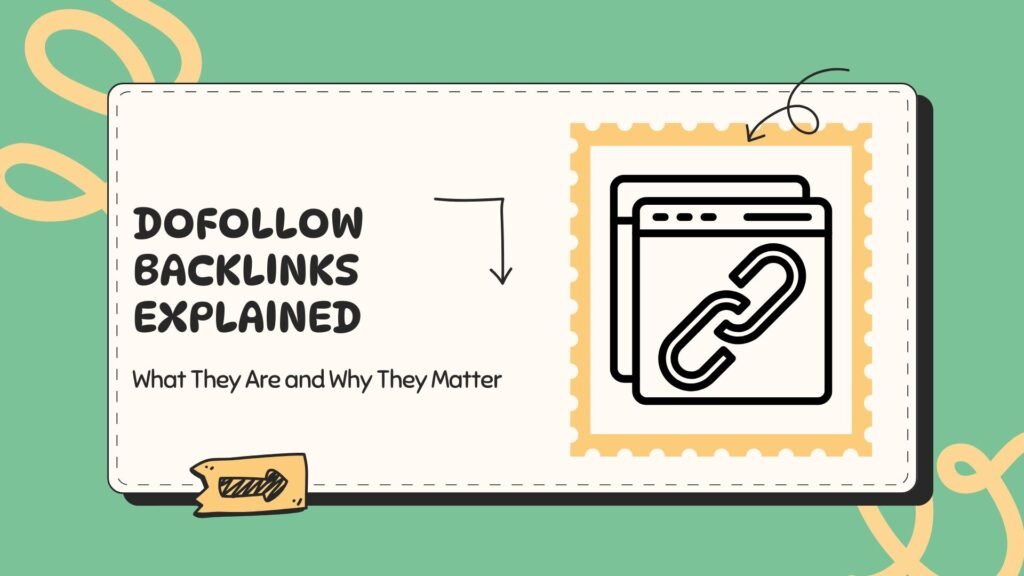
If you are trying to rank your website higher on Google, you have probably heard the term dofollow backlinks. But what exactly are they? And why does everyone in SEO keep talking about them?
In this blog, we will break it all down in simple words. You will learn what dofollow backlinks are, how they work, and most importantly—why they can help your website grow faster and rank better. Whether you are just starting with SEO or looking to improve your link-building game, this guide will give you all the clarity you need.
Let’s get started with the basics.
What Are Backlinks?
First, let us start with the basics.
Backlinks are links that go from one website to another. For example, if another site links to your blog, that link is called a backlink.
Think of it as a vote. That site is saying, “Hey, this page is worth checking out.”
Now, not all backlinks are the same. Some give your site more power. Some do not. That is where dofollow and nofollow come in.
Dofollow vs Nofollow Links
There are two main types of backlinks:
- Dofollow links
- Nofollow links
Both are links. But they work differently.
Let us look at what makes them different.
Dofollow Backlinks
A dofollow backlink is a regular link. It tells search engines like Google, “Hey, I trust this website.” And when Google sees that, it gives some credit to your page. That credit is often called link juice.
So, dofollow links help your website rank higher in search results.
Nofollow Backlinks
A nofollow backlink still links to your site. But it tells search engines not to follow it. So, you do not get much or any link juice from it.
These links are still useful. But they do not carry the same SEO power as dofollow links.
Why Do Dofollow Backlinks Matter?
Now that you know what they are, let us talk about why people care about dofollow links so much.
Here is why they matter:
1. They Help You Rank Higher
This is the big one.
Dofollow backlinks tell search engines that your site is trusted. The more good dofollow links you have, the higher your chances of showing up on page one of Google.
2. They Bring Traffic
When someone clicks on a dofollow link to your site, they land on your page. Simple as that.
So not only do you get SEO power, but you also get real visitors.
3. They Build Authority
When high-quality websites link to you, it boosts your credibility. It shows you are not just some random website. You are someone worth linking to.
4. They Help Search Engines Find You
Google uses links to discover new pages. Dofollow links help search engines crawl your website better.
What Do Dofollow Links Look Like?
You might not always see the difference just by looking. But in the HTML code, here is the trick.
A dofollow link looks like this:
php-template
<a href=”https://yourwebsite.com”>Visit Here</a>
A nofollow link has an extra part:
php-template
<a href=”https://yourwebsite.com” rel=”nofollow”>Visit Here</a>
That little rel=”nofollow” tells Google to ignore the link for SEO purposes.
Where Can You Get Dofollow Backlinks?
If you want dofollow backlinks, you need a plan. Random links here and there will not do much. So here are ten smart ways you can use to build strong dofollow links that actually help your site.
1. Guest Posting
Write helpful articles for other blogs in your niche. In return, they usually allow you to include one or two dofollow links to your site. Just make sure the blog is trusted and active.
2. Create Link-Worthy Content
Make content that others want to link to. This could be:
- A useful guide
- A free tool
- A checklist
- An original study
- A how-to post
If it helps people, they will link to it.
3. Reach Out with Emails
Find sites that already write about your topic. Offer them your content as a helpful resource. Keep it short and friendly. No pressure. Some will say yes.
4. Use Broken Link Building
Find broken links on other sites. Offer your content as a replacement. This helps them fix their site and gets you a backlink too. It is a win-win.
5. Use HARO
Sign up for Help A Reporter Out (HARO). Reply to journalist questions. If they like your answer, they will include it in their article and give you a backlink.
6. Get Featured in Roundups
Some blogs do expert roundups or lists like “Top Tools” or “Best Blogs.” Try to get featured in those by reaching out or just creating awesome content.
7. Share Original Data
If you do a survey or share data no one else has, people will link to it. Data is powerful. Just make sure it is clear and easy to understand.
8. Repurpose Content
Turn your blog posts into infographics, videos, or slides. Share them on other platforms like YouTube, SlideShare, or Pinterest. Some of these give dofollow links in your profile or descriptions.
9. Be Active in Communities
Join forums, Q&A sites, and groups where your audience hangs out. Help others. Drop your link only when it makes sense and adds value. Some of these communities allow dofollow links.
10. Collaborate with Others
Work with other bloggers, businesses, or creators. You can exchange content, do interviews, or launch something together. These partnerships often lead to natural dofollow links.
What Makes a Good Dofollow Backlink?
Not all dofollow backlinks are created equal. Some are gold. Others are just… okay.
Here is what makes a backlink really good:
1. Relevant Website and Content
- The backlink should come from a website that is related to your niche or industry.
- The surrounding content should also make sense contextually — it should naturally mention or connect to your content.
- Example: If you run a SaaS business that offers a project management tool, getting a backlink from a blog about team collaboration tools is highly relevant.
2. High-Quality Source
- A site with strong metrics (e.g., high organic traffic, trusted by search engines) offers more value.
- Avoid spammy directories or sites with poor design and low-quality content.
- Tip: Use tools like Ahrefs or Semrush to check traffic and backlink profile before pursuing a link.
3. Proper Placement Within the Content
- The link should be placed within the body of the content, not in the footer, sidebar, or author bio.
- Contextual backlinks carry more SEO weight.
- Example: A mention inside a well-written blog article is better than a list of links at the bottom of a page.
4. Anchor Text Optimization
- The anchor text (the clickable text of the backlink) should be descriptive and relevant.
- It’s best to use a mix: branded terms, exact-match keywords, and natural phrases.
- Avoid over-optimization or exact-match anchors every time — that can raise red flags with Google.
5. Natural and Organic
- Backlinks should appear as a result of valuable content — not obviously paid or forced.
- Google favors links that are earned through genuine recommendations or editorial mentions.
6. Indexable Page
- The page giving you the backlink should be indexed by Google — otherwise, the link won’t pass any SEO value.
- You can check this by doing a site:URL search in Google to see if the page is indexed.
7. No Link Spam Nearby
- If your link is surrounded by lots of low-quality or spammy outbound links, it can devalue your backlink.
- Quality over quantity always wins.
8. Diverse Link Profile
- A healthy backlink profile includes dofollow links from different domains, IPs, and regions.
- Getting all your links from one type of site (like only directories or only guest posts) looks unnatural.
Common Mistakes People Make
Let us be real. Everyone makes mistakes with backlinks at first. But you can avoid them.
Here are some common ones:
1. Buying Bad Links
Yes, people sell backlinks. But many of them are low-quality or from spammy sites. Google hates this. You could get penalized.
2. Ignoring Relevance
Getting a link from a cooking blog when you run a tech site? That is not helpful. Stick to your niche.
3. Focusing Only on Quantity
One good backlink can do more than fifty bad ones. Quality wins every time.
4. Using Only One Strategy
Do not just guest post. Mix it up. Try different ways to get links.
Are Nofollow Links Useless?
Not at all. Even though they do not pass link juice, they still help in other ways:
- Bring traffic
- Build your brand
- Increase visibility
- Can lead to more dofollow links later
So yes, they still matter.
How Many Dofollow Links Do You Need?
There is no perfect number.
It depends on:
- Your competition
- Your niche
- Your goals
Some websites rank with just a few. Others need hundreds. Focus on getting the best ones you can. And keep going.
Can You Check If a Link Is Dofollow?
Yes, and it is easy.
Use a Chrome Extension
Tools like NoFollow or SEOquake highlight dofollow and nofollow links on any page.
Inspect the Page
Right-click on a link and choose “Inspect”. You will see the HTML code. If there is no rel=”nofollow”, it is dofollow.
Quick Tips to Earn Dofollow Links
Let us wrap up with a list of quick, simple tips:
- Share your content on social media
- Comment on blogs (some give dofollow links)
- Join online communities in your niche
- Answer questions on forums like Quora or Reddit
- Create infographics others can share
- Offer free tools or templates
- List your site on trusted directories
- Collaborate with other bloggers
Final Thoughts
Dofollow backlinks are a big deal. They help your website get noticed by Google. They bring you traffic. They show that people trust your site.
But remember this: it is not just about links. It is about building relationships, sharing value, and growing over time.
So focus on creating great stuff. Talk to others in your field. Share helpful content. And those dofollow backlinks? They will come.
You got this.


